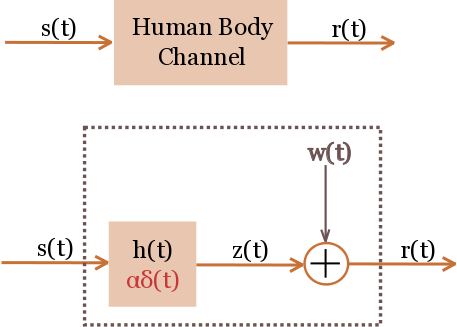- "A Review of Wearable Antenna"
- "New Wideband Printed Antennas for Medical Applications"
Body-coupled communication
Communicate ... with a human touch!
torsdag 24 april 2014
Today's session
We are preparing a submission of our work on printed electrode to the SSOCC conference. The conference is this year in Vadstena, in the western parts of county of Östergötland.
As references we have two interesting papers on:
onsdag 26 mars 2014
A simple mathematical model for attenuated HBC channel
It has been proven widely
and largely by a number of researchers that human body is essentially
an attenuated transmission channel. This means that this attenuated
channel could be modeled as a deterministic linear time-invariant
filter with impulse response h(t) as shown in the figure below.
In this case h(t) could
be represented as,
In this figure s(t) is the transmitted signal, w(t) represents additive white gaussian noise and z(t) is the convolution of s(t) with h(t).
So r(t) is given by,
If
måndag 17 mars 2014
60-Hz power line interference with human body
60-Hz power line interference could either couple through electromagnetic induction or through electrostatic induction to the underlying circuit.
Electromagnetic Induction
The magnetic field due to mains supply current induces electromotive force (emf) in the electrodes, associated lead wires and preamplifier of the BAN trannsceiver. The greater the loop area covered by the mains supply current, the larger is the value of induced emf. However when the same electrodes, lead wires and preamplifier are worn on the body, there is very little amount of induced emf in the receiver due to much lesser loop area.
Electrostatic Induction
In case of electrostatic induction, the mains supply current gets capacitively coupled to the human body. The body-to-ground capacitance plays an important role in introducing interference as the pre-amplifier is also isolated from true earth or gound in battery held devices. A displacement current therefore flows through the human body which produces common mode voltage at the electrodes with respect to ground.
It is assumed that electrostatic induction is the dominant form of interference for BAN transceiver rather than electromagnetic induction.
söndag 23 februari 2014
HBC channel defined by IEEE 802.15.6
IEEE 802.15.6 channel
modeling subcommittee
has approved measurements for frequency range
13.550 to 13.571 MHz
and the surprising result is that human body
exhibits almost similar path loss as that of free space for a narrow
band of 21 kHz. According to these measurements, signal amplitude
reduction through the regions of hand, wrist, torso (front to back),
thigh, ankle, left to right ear is 3.3 %, 2.8 %, 3.4 %, 1.9 %, 2.8 %
and 2.0 % respectively [1].
It has also been specicified
that human body can be used as a communication channel from 5 to 50 MHz
without need of any modulation. It has been shown that for a
transmission distance of 150 cm from the fingertips of one to the
fingertips of the other hand with receiver load impedance of 10 M-ohm
and electrode sizes of 2x2 cm2 the amplitude and phase
mean value of response is as follows at different frequencies [1].
|
|
5 MHz |
10 MHz |
20 MHz |
30 MHz |
40 Mhz |
50 Mhz |
|
Amplitude (dB)
|
-47.2 dB |
-48 dB |
-48.65 dB |
-50.7 dB |
-52 dB |
-54.8 dB |
|
Phase (degrees)
|
-29.2 º |
-47.4 º |
-87.7 º |
-117.6 º |
-150 º |
- 172.7 º |
The channel also exhibits
Gaussian noise with zero mean and 2.55×10-5
variance.
References
[1] K.-Y. Yazdandoost and
K. Sayrafian, “Channel model for body area
network (BAN),”
15-08-0033-04-0006-draft-of-channel-model-for-
body-area-network.doc
https://mentor.ieee.org/802.15/file/08/15-08-0780-09-0006-tg6-channel-model.pdf
Prenumerera på:
Inlägg (Atom)




